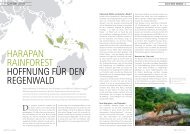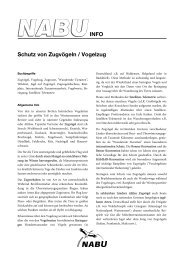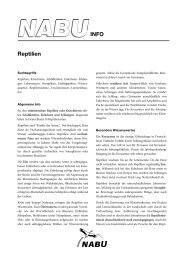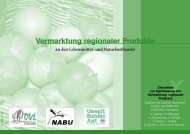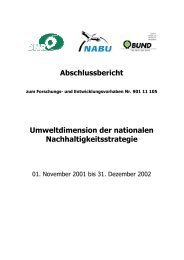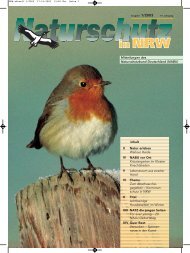Studie "The GMO-emperor has no clothes" (engl.) - Nabu
Studie "The GMO-emperor has no clothes" (engl.) - Nabu
Studie "The GMO-emperor has no clothes" (engl.) - Nabu
You also want an ePaper? Increase the reach of your titles
YUMPU automatically turns print PDFs into web optimized ePapers that Google loves.
wild B. campestris. <strong>The</strong> results of the Danish team<br />
showed that high levels of hybridization can occur<br />
in the field. <strong>The</strong>ir field tests revealed that between<br />
nine percent and 93 percent of hybrid seeds were<br />
produced under different conditions. (Jorgensen,<br />
R.B and Anderson, B., (1994), “Spontaneous<br />
Hybridization between oilseed rape (Brassica<br />
Napus) and weedy B.Campestriz (Brassicaceae): A<br />
risk of growing genetically modified oilseed rape”,<br />
American Journal of Botany).<br />
<strong>The</strong> scientists also warn that as the gene for<br />
herbicide resistance is likely to be transferred to the<br />
weed, this herbicide strategy will be useless after a<br />
few years. Like many other weeds, B. campestris is<br />
characterized by seed dormancy and longevity of<br />
the seeds. <strong>The</strong>refore, B. campestris with transgenes<br />
from oilseed rape may be preserved for many years<br />
in spite of efforts to exterminate it. <strong>The</strong>y conclude<br />
that weedy B. campestris with this herbicide<br />
tolerant transgene may present eco<strong>no</strong>mic risks to<br />
farmers and the biotech<strong>no</strong>logy industry. Finally,<br />
natural ecosystems may also be affected.<br />
Other concerned scientists add that the potential<br />
spread of the transgene will indeed be wide<br />
because oilseed rape is insect-pollinated and bees<br />
are k<strong>no</strong>wn to fly far distances. <strong>The</strong> existence of the<br />
wild relative of B. campestris in large parts of the<br />
world poses serious hazards once the transgenic<br />
oilseed rape is marketed commercially. In response<br />
to the Danish findings, the governments of<br />
Denmark and Norway have acted against the<br />
commercial planting of the engineered plant, but<br />
the U.K Government <strong>has</strong> approved its marketing.<br />
Wild beets have become a major problem in<br />
European sugar beet production since the 1970s.<br />
<strong>The</strong>se weedy populations arise from seeds<br />
originating from the accidental pollinations of<br />
cultivated beets by adventitious beets in the seed<br />
production area. <strong>The</strong> existence of gene exchange<br />
via seed and pollen between weed beets and<br />
cultivated beets shows genetically engineered<br />
sugar beets to be herbicide resistant, with the<br />
possibility of becoming “super-weeds.” In this<br />
case, the efficacy of herbicide resistant crops<br />
totally undermined. (P. Bondry, M. Morchen, P.<br />
Sanmiton-Laprade, Ph. Veernat, H.Van Dyk, “<strong>The</strong><br />
origin and evolution of weed beets: Consequences<br />
for the breeding and release of herbicide resistant<br />
transgenic sugar beets: <strong>The</strong>or-Appl Genet (1993),<br />
87:471-78).<br />
Current surveys indicate that almost 20 percent<br />
of U.S producers have found glyphosate resistant<br />
(Roundup Resistant) weeds on their farms. (http://<br />
farmindustrynews.com/crop-protection/diversificationprevents-weed-resistance-glyphosate)<br />
Referring to Round Up Resistant weeds,<br />
Andrew Wargo III, the President of the Arkansas<br />
Association of Conservation Districts said, “It is<br />
the single largest threat to production agriculture<br />
that we have ever seen”. (William Neuman &<br />
Andrew Pollack, Farmers Cope with Round-Up<br />
Resistance Weeds, New York Times, 4th May<br />
2010).<br />
<strong>The</strong>re are <strong>no</strong>w ten resistant species in at least 22<br />
states infesting millions of acres, predominantly<br />
soybeans, cotton, and corn. Roundup Resistant<br />
weeds include pig weed, rag weed, and horse<br />
weed.<br />
Today, Roundup Ready crops account for 90<br />
percent of soybeans and 70 percent of corn and<br />
cotton grown in the US.<br />
Mike Owen, a Weed Scientist at Iowa State<br />
University <strong>has</strong> cautioned: “What we’re talking<br />
about here is Darwinian evolution in fastforward.”<br />
As a result of this weed resistance, farmers are<br />
being forced to use more herbicides to combat<br />
weeds. As Bill Freese of the Center for Food Safety<br />
in Washington, D.C., says “<strong>The</strong> biotech industry<br />
is taking us into a more pesticide dependent<br />
agriculture, and we need to be going in the<br />
opposite direction.”<br />
<strong>The</strong> problem of “superweeds” is so severe that<br />
U.S Congress organized a hearing on it titled “Are<br />
Superweeds on Outgrowth of USDA Biotech<br />
Policy”.<br />
(http://westernfarmpress.com/management/super-weedsput-usda-hotseat)<br />
Superweeds infest a GM corn field<br />
As Roy Troush, an Indiana farmer, stated in his<br />
testimony: “In 2005 we first began to encounter<br />
problems with glyphosate-resistance in both our<br />
soybean and corn crops. Despite well documented<br />
proof that glyphosate tolerant weeds were<br />
becoming a significant problem, the Monsanto<br />
14



